I confess to changing my choice today to Perfect Poetry Book Friday, but with good reason. This book deserves wide promotion and it fits perfectly into the aims of our blogging group to recommend high quality books with pictures for … Continue reading
Add a CommentViewing: Blog Posts Tagged with: laura purdie salas, Most Recent at Top [Help]
Results 1 - 25 of 29
Blog: Miss Marple's Musings (Login to Add to MyJacketFlap)
JacketFlap tags: photos, poetry, homeschooling, Joseph Bruchac, Book recommendation, National geographic, Laura Purdie Salas, Emily Dickenson, Billy Collins, Rebecca kai Dotlich, teaching resources, Perfect Picture Book Friday, Renee LaTulippe, book of nature poetry, elementary classrooms, J Patrick Lews, World Wildlife Conservation Day, Add a tag
Blog: Teaching Authors (Login to Add to MyJacketFlap)
JacketFlap tags: writing exercise, Laura Purdie Salas, Lisa Bullard, Carmela Martino, Writing Workout, writing for hire, Mentors for Rent, Wednesday Writing Workout, Children's Writer's and Illustrator's Market (CWIM), Add a tag
Today, I'm happy to welcome back former TeachingAuthor Laura Purdie Salas with a guest Wednesday Writing Workout tailor-made for our current TeachingAuthors' series on how we each "Make a Living as a Writer." Laura was one of the authors I interviewed for my article of the same title that appears in the 2016 Children's Writer's & Illustrator's Market, edited by Chuck Sambuchino (Writer's Digest Books). If you haven't entered our drawing for a chance to win your own copy of the 2016 CWIM, be sure to do so here, AFTER you try Laura's eye-opening writing exercise below.
<!--[if gte mso 9]> Wednesday Writing Workout:
Wednesday Writing Workout:
The Cinderella Trifecta: Is Writing on Assignment Right for You?
by Laura Purdie Salas
Hey, it’s fun to be back here at TeachingAuthors I was honored to be interviewed for Carmela's terrific article in the 2016 Children’sWriter’s & Illustrator’s Market.
 |
| BookSpeak! - trade market |
 |
| Water Can Be... - trade market |
 |
| Colors of Fall - education market |
 |
| Y Is for Yowl! - education market |
Laura Purdie Salas
Blog: Miss Marple's Musings (Login to Add to MyJacketFlap)
JacketFlap tags: Perfect Picture Book Friday, Violeta Dabija, No water River, A ROCK CAN BE, picture book, poetry, nonfiction, Laura Purdie Salas, rocks, Add a tag
Title: A Rock Can Be Written by: Laura Purdie Salas Illustrated by: Violeta Dabija Published by: Millbrook Press, 2015 Themes/Topics: rocks, nonfiction, poetry, rhyme Suitable for ages: 5-8 Opening: A rock is a rock. … Continue reading
Add a CommentBlog: Teaching Authors (Login to Add to MyJacketFlap)
JacketFlap tags: Flip Float Fly: Seeds on the Move, Marcie Flinchum Atkins, Poetry Friday, Nonfiction, April Pulley Sayre, Laura Purdie Salas, creative nonfiction, JoAnn Early Macken, Lola Schaefer, Fiona Bayrock, Add a tag
In this series of Teaching Author posts, we’re discussing the areas of overlap between fiction and nonfiction. Today, I’m thinking about creative nonfiction.
What is Creative Nonfiction? According to Lee Gutkind (known as the “Father of Creative Nonfiction”), “The words ‘creative’ and ‘nonfiction’ describe the form. The word ‘creative’ refers to the use of literary craft, the techniques fiction writers, playwrights, and poets employ to present nonfiction—factually accurate prose about real people and events—in a compelling, vivid, dramatic manner. The goal is to make nonfiction stories read like fiction so that your readers are as enthralled by fact as they are by fantasy.”
One critical point about writing creative nonfiction is that creativity does not apply to the facts. Authors cannot invent dialog, combine characters, fiddle with time lines, or in any other way divert from the truth and still call it nonfiction. The creative part applies only to the way factual information is presented.
Fiona Bayrock’s “Eleven Tips for Writing Successful Nonfiction for Kids” lists more helpful and age-appropriate methods for grabbing kids’ attention, starting with “Tap into your Ew!, Phew!, and Cool!”
Marcie Flinchum Atkins has compiled a helpful list of ten Nonfiction Poetic Picture Books. She points out that these excellent books (including some by Teaching Authors friends April Pulley Sayre, Laura Purdie Salas, and Lola Schaefer) can be used in classrooms to teach good writing skills. We can all learn from such wonderful examples!
Heidi Mordhorst has this week’s Poetry Friday Roundup at My Juicy Little Universe. Enjoy!
JoAnn Early Macken
Blog: Teaching Authors (Login to Add to MyJacketFlap)
JacketFlap tags: Poetry Friday, Richard Wright, Laura Purdie Salas, J. Patrick Lewis, Mother's Day, Melissa Sweet, Paul B. Janeczko, April Halprin Wayland, poetry anthology, Best Books 2014, short poems, Add a tag
.
Howdy Campers!
Yippee!--it's Poetry Friday! (the link's at the end of this post ~)
Confession regarding the title of this post: I lied. Although there were many wonderful poetry books this year, I'm going to talk about just one.
You may already have read it...or read about it on Laura Purdie Salas' TeachingAuthors post in May.
You may already know that it's gotten starred reviews in Publisher's Weekly, Kirkus, Booklist and School Library Journal.
You may have heard that it's one of Publisher's Weekly's Best Picture Books of 2014, it's a School Library Journal Best Nonfiction Book of the Year, it's in the American Booksellers Association Best Books for Children Catalog, and it's on lists predicting the 2015 Caldecott for illustrator Melissa Sweet.
Blog: Teaching Authors (Login to Add to MyJacketFlap)
JacketFlap tags: Laura Purdie Salas, transitions, Jill Esbaum, Carmela Martino, Mary Ann Rodman, Add a tag
This is a time of transitions here on the TeachingAuthors blog. Laura announced on Friday that she is leaving our team. Even though she'd signed on as a temporary sub, I'd hoped we'd be able to convince her to continue as a regular. Unfortunately, other pressing demands are tugging at her. But I do hope she'll keep us in mind if circumstances change. J
Meanwhile, we wish her the best. At least we'll all be able to keep tabs on Laura over at her own blog.
 |
| Farewell to the lovely and talented, Laura Purdie Salas! |
 |
| We're going to really miss the wise and wonderful, Jill Esbaum! |
| Mary Ann's BACK! YIPPEE! |
I WILL tell you though, that we'll be sponsoring another great book giveaway this month! Be sure to see April's post this Friday for details.
Happy writing, all.
Carmela
Blog: Teaching Authors (Login to Add to MyJacketFlap)
JacketFlap tags: Lilian Moore, Poetry, Poetry Friday, Laura Purdie Salas, Add a tag

Today is my last post as a member of the Teaching Authors blog, and I'm kind of melancholy about it. Stepping down is my choice, and I knew my time here was temporary when I agreed to do it. And there are several good reasons I need to leave the group--time being the most pressing. So in some ways it's a relief.
But...but...I am so amazed by these writers! They talk and brainstorm and support each other behind the scenes much more than I expected. They are a great group--and if I didn't have a blog of my own and too many commitments, I would be honored to stay here with Carmela, April, Esther, and JoAnn. In fact, I wish I had met up with this group years ago! You know how you meet people sometimes and think, "If I had met this person 20 years ago, I bet my life would be different right now"? That's kind of how I feel about the Teaching Authors. They might be surprised to hear this, because I've barely had time to answer emails, and I also chose not to participate in conversations and group decisions too deeply, knowing I would be saying goodbye before too long.
OK, enough melodrama, but, in honor of my somewhat melancholy mood about this, I'm sharing this poem by Lilian Moore, one of my favorite poets. This is from Something New Begins, which is out of print, but Amazon has some used copies, which I urge you to grab! It originally appeared in I Feel the Same Way. I love the slightly bittersweet beauty of so much of her nature poetry.
Until I Saw the Sea
Until I saw the sea
I did not know
that wind
could wrinkle water so.
I never knew
that sun
could splinter a whole sea of blue.
Nor
did I know before,
a sea breathes in and out
upon a shore.
--Lilian Moore, all rights reserved
Isn't that lovely? Sigh... Now, head on over to Laura Shovan's Author Amok blog for the Poetry Friday Roundup!
Blog: Teaching Authors (Login to Add to MyJacketFlap)
JacketFlap tags: Poetry Friday, Writing Process, Laura Purdie Salas, J. Patrick Lewis, personal writing habits, technology in writing, writing longhand, Add a tag
Happy Poetry Friday! Y'all are going to start to think that I only read poetry by J. Patrick Lewis. That is not true, though he is so versatile and prolific that I could share new poems here every time I post, and you would still enjoy a terrific variety, a great education in the art of poetry. I recently received a review copy of his forthcoming Everything Is a Poem: The Best of J. Patrick Lewis (Creative Editions, 2014). That's right. Pat is a rock star, and he has a greatest hits album!
I devoured this book start to finish, and I adore it. It collects some of his poems from the 1980s up to 2010. The topic categories include Animals, People, Reading (yes!), Sports (eh--only because I'm not a sports fan), Riddles and Epitaphs, Mother Nature(always my favorite), Places, and A Mix. The forms cover a huge range, from free verse to rhyming to specific poetic forms. If you're a fan of Lewis' work (and if not, why not?), do not miss this collection.
It was tough choosing just one to share, as there are around 60 poems here. But this is one of my very favorites:
What a Day
Out of dark's rougher neighborhoods,
Morning stumbles,
none too
bright,
recalling now
the thief,
Night,
who stole her work
of art--
Light.
--J. Patrick Lewis, all rights reserved
Here I am reading this poem:
Now, on to the question of longhand vs. keyboarding, the conversation Carmela started earlier this week. I come down firmly on the side of keyboarding. I do my morning pages that way (sorry, Julia Cameron), I do my nonfiction this way, and I do my poetry this way. At least, I prefer to. I do sometimes write longhand, usually when I'm on the road and don't have a keyboard handy. (Even then, I often carry a portable keyboard that works with my iPhone and is amazing!)
I feel stilted and uncomfortable writing in longhand. My hand can't keep up with my brain, and I can feel the ideas and phrases slipping away faster than I can record them. It's like being trapped in a cave where all this treasure is quickly draining down a hole in the floor, and I only have a tiny spoon to try to grab diamonds before they disappear. So, give me a keyboard any day!
One thing I don't mind doing at all in longhand is brainstorming. If I'm coming up with ideas or just playing around with thoughts on an existing piece, I'll happily make lists and charts and such. For example, when I was first working on poems for a night collection that will come out from Wordsong, I filled a little notebook with thoughts and possibilities.
I will say that when I did Riddle-Ku on my blog for National Poetry Month, I wrote 95% of those while riding in a car along Lake Superior in February. I had a little mini-notebook just for that project, and every time I sat down in that seat and picked up my notebook, the poems started pouring out. For very short poems, I don't mind writing longhand. But...if I'd had my keyboard in the car with me and if my phone's battery lasted longer, I'd probably have been typing:>)
You don't have to write longhand OR by keyboard to go enjoy some more poetry! Poet and teacher Heidi Mordhorst at Juicy Little Universe has today's Poetry Friday Roundup--so don't miss it!
And if you haven't already done so, don't forget to enter our current giveaway for a chance to win the historical middle-grade novel Odin's Promise (Crispin Press) by Sandy Brehl. See JoAnn's post for all the details.
--Laura
Blog: Teaching Authors (Login to Add to MyJacketFlap)
JacketFlap tags: reading, Poetry Friday, poem, Laura Purdie Salas, J. Patrick Lewis, Writing Classes, George Ella Lyon, book-a-day, UCLA Extension Writers Program, Add a tag
For Poetry Friday, I'm sharing a poem from a book coming out this fall from J. Patrick Lewis and George Ella Lyon. I just received an ARC of Voices from the March on Washington (WordSong), and I've only read three of the poems. But they all knocked my socks off! I'll share more closer to the publication date, but here's a sneak peek to whet your appetite.
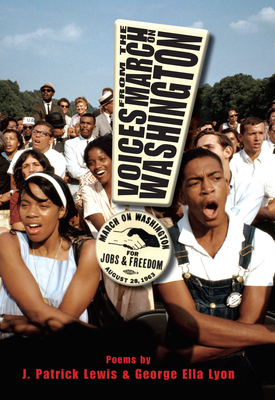 Last Impressions
Last Impressions
black without white
is
a moonless
night
empty
as
a life
of endlessly
falling snow
is
white without black
--J. Patrick Lewis, all rights reserved
This lovely poem especially connected with me because I just wrote three poems about diversity for consideration for a friend's scholarly book on children's literature, and the one he chose uses blizzard/snow imagery as well!And I love the way you can create many different complete thoughts that kind of overlap each other because of the line breaks. Gorgeous.
Here I am reading Pat's poem:
Sylvia Vardell and Janet Wong, creators of the amazing Poetry Friday Anthology books, are hosting the Poetry Friday Roundup at Poetry for Children. Don't miss it!
Now on to what I've been reading. I've been working on attacking my to-read shelf this summer! I joined the Book-a-Day Challenge through Donalyn Miller and the Nerdy Book Club (http://nerdybookclub.wordpress.com/2014/05/18/the-sixth-annual-book-a-day-challenge/). My goal is to average a book a day (surprise:>) And it's not too late! You pick your start and stop days, so if you have one month left of summer, go for it. Commit to reading a book a day, and share your books on your blog or Twitter (#bookaday). I post mine on Twitter--that accountability is great. Anyway, the thing I've learned most is that having a book-a-day really helps me get to a lot more picture books and poetry books--which are my favorite books, anyway. But they often get lost in the shuffle as I read research books or escape into mysteries. Below are the most recent 10 books I've finished. I have more in progress.
Looking over my list, I would say two other things I've learned are that I abandon books without guilt now (a major change from 10 years ago), and I want to read MORE picture books and poetry. Once book-a-day ends, I might have to come up with a picture book plan to keep me going!
P.S. Check that last book for the most finely-crafted nonfiction picture book I've read in months.
P.P.S. Those of you in the Los Angeles area who are aspiring picture book writers, check out Teaching Authors' April Halprin Wayland's upcoming class, Writing Picture Books for Children. It's Wednesday nights from August 6 through September 10. It might be just right for you, so don't miss out :>)
Happy reading,
Laura
Laura's bookshelf: read

Blog: Teaching Authors (Login to Add to MyJacketFlap)
JacketFlap tags: Poetry, Poetry Friday, Book Giveaway, Laura Purdie Salas, marketability, Joan Bransfield Graham, Add a tag
Minnesota: The Birth of Old Man River
A lake creates a lazy stream
That flows through pines and slips away,
Then picks up barges, logs and steam,
Becomes a mighty waterway.
Walk on rocks across this sliver,
Cross the current, slow and mild.
It will grow to Old Man River
Though for now it’s still a child.
--Laura Purdie Salas, all rights reserved
---------------------------------------------------------------------------
The headwaters of the Mississippi River are in Lake Itasca, Minnesota. At its start, the river is narrow and shallow, and you can cross the Mighty Mississippi by walking across some rather slippery rocks.
 | |
|
Here I am reading the poem:
Happy Poetry Friday! And welcome to my musings on our current topic, marketability of our manuscripts, and what we do with our unmarketable work.
Ah, this is such a touchy topic! As a poet, marketability is even MORE of a challenge than most other formats/genres. And as my career progresses, I am even more aware of this, always, because I need to make a certain income and want to earn that income by creating books I love. So, do I think about whether a project is marketable before I start it? Absolutely. If I decide it is not, what do I do? I might still write it, if it's something I feel like I just HAVE to write. But if it's not something I have to write, then I might skip it. I have way more ideas than I have time to write, so it's a matter of prioritizing. What project am I excited about writing that I think has at least a decent chance of selling to a publisher? That's what I take on.
Unfortunately, I usually don't realize a project is unmarketable until it's too late! Take my 50 state poems (please, publisher, take it!). Above is the Minnesota poem from that collection, plus a photo I took Tuesday at the headwaters.
So, what's my solution? Well, I have 6 poetry collections that I want to get out there. Four of them got lovely, wonderful responses from editors--some even went to acquisitions--but were deemed too hard to sell. Another one never went out because my agent felt it wasn't strongly marketable, and the final one I wrote for my blog in April. I am having trouble moving on from these unpublished collections. So...I've decided to e-publish them. I've got wonderful educators writing some teaching activities, and I'm going to try to market them TO educators, primarily.
I am fairly certain I won't recoup the monetary cost of producing the books (I'm estimating about $2,000 for the six books together), because self-published e-books typically DON'T sell well at all. At. All. Not to mention the many hours of work it will take. But my big hope is that I will connect with more teachers and librarians, spread some poetry love, and, ultimately, share my name and work. And that I can get some closure and put all my creative energy into new projects instead of constantly looking backward at what feels like unfinished business.
P.S. Don't get me wrong. I have LOADS of unpublished, unmarketable manuscripts that I would not consider putting out there. Some manuscripts are unmarketable for good reason:>)
P.P.S. Jone at Check It Out (who does the wonderful April poetry postcards!) has the Poetry Friday Roundup. Enjoy!
P.P.P.S. It's almost the end of our Rafflecopter Giveaway for Joan Bransfield Graham's THE POEM THAT WILL NOT END. Just go here and click on the link at the very end of the post. Good luck!
--posted by Laura Purdie Salas
Blog: Teaching Authors (Login to Add to MyJacketFlap)
JacketFlap tags: Poetry, Poetry Friday, Book Giveaway, Laura Purdie Salas, Add a tag
 Happy Poetry Friday! I finally just had a chance to read Pug and Other Animal Poems, by Valerie Worth, illustrated by Steve Jenkins. The poems are, of course, wonderful. I was trying to choose between several fabulous ones to share. The cries of Canada geese flying above in Minnesota in autumn and spring are one of my very favorite sounds, so I decided to go with this one. Since this has been a long winter with a late spring, I've been hearing this spring music a lot this past month.
Happy Poetry Friday! I finally just had a chance to read Pug and Other Animal Poems, by Valerie Worth, illustrated by Steve Jenkins. The poems are, of course, wonderful. I was trying to choose between several fabulous ones to share. The cries of Canada geese flying above in Minnesota in autumn and spring are one of my very favorite sounds, so I decided to go with this one. Since this has been a long winter with a late spring, I've been hearing this spring music a lot this past month.Geese
Then, they
Wavered away
Down the cold
Sky, with cries
Like grieving;
Now, we
Hear in those
Same high voices
Returning, a noisy
Rejoining!
--Valerie Worth, all rights reserved
I adore that cold sky and repeated sounds in here (sky/cries; voices/noisy/rejoicing). It reminds me of the sound diagramming exercise/post I did several years ago. I'm revising a project for an editor right now, and I think I'll put this technique to use as I work on this. Have you ever tried anything like that?
The Poetry Friday Roundup is being hosted by the smart and prolific Diane Mayr at Random Noodling--go check it out!
And today, Friday, is your very last chance to enter our current giveaway for Debbie Dadey's Mermaid Tales: Treasure in Trident City.
--Laura Purdie Salas
Blog: Kid Lit Reviews (Login to Add to MyJacketFlap)
JacketFlap tags: children's book reviews, Laura Purdie Salas, Millbrook Press, water, Lerner Publishing Group, 5stars, Violeta Dabija, Library Donated Books, forms of water, water properties, Children's Books, Picture Book, poetry, Favorites, Add a tag
 .
.
by Laura Purdie Salas & Violeta Dabija, illustrator
MillBrook Press 4/01/2014
978-1-4677-0591-2
Age 4 to 8 32 pages
.
“Water can be a . . . Thirst quencher. Kid drencher. Cloud fluffer. Fire snuffer. Find out about the many roles water pays in this poetic exploration of water throughout the year.”
Opening
“Water us water—
it’s puddle, pond sea.
When springtime comes splashing,
the water flows free.”
Review
Water Can Be . . . is the second Laura Purdie Salas picture book reviewed here at KLR. The first was A Leaf Can Be . . . (reviewed here) which is about all the things a leaf can be that we never think about or realized. In that same vain, Water Can Be . . . is about all the things we may not notice about water. Told in rhyming text, the story needs the illustrations, as the two together make the wonderful story of what Water Can Be . . .
There are a few things that water can become that I had not thought of. We all know that snow is water, rain is water, and my personal favorite, ice is water. Have you ever heard of a “woodchuck warmer?” Did you know that water heavily influences the woodchuck warmer? Me either. I had no idea what a woodchuck warmer is, or that water was involved, and honestly, the illustrations failed me on this. It looks like an animal sleeping under a blanket of leaves.
In the back of the book, the author wrote a guide to each thing water could be. Thanks to that guide, I can explain how a woodchuck warmer and water influence each other. Woodchucks burrow in the ground and hibernate. If not for the snowfall atop the leaves that lay upon the burrow opening, and across the land above the burrow, these winter homes would become tragically cold and the woodchucks would most likely not survive the winter. Water, now in the form of snow, acts as an insulator. That is one heck of a job for water and it works wondrously.
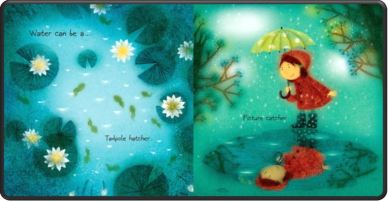
The illustrations are gorgeous, just as they were in A Leaf Can Be . . . but the author presents the water possibilities in a scattered manner. Spreads jump from a light image, say of two kids playing in a water sprinkler or fluffer clouds, to a ship at trouble in a storm or a firefighters putting out a forest fire, as birds quickly fly away, sometimes in the same spread. Most images are in shades of bluish-green, some darker than others. My favorite illustration is water as a picture catcher. A young girl looks at herself in the smooth surface of a little pond and sees a reflection of herself. The illustration is fantastic. I love that the facial expressions are nearly identical and the nice shade of red in the girl’s coat.
Each thing water can become is beautifully visualized so kids can instantly understand the two-word concepts presented, such as thirst quencher / kid drencher and home maker / ship breaker. Younger children will grasp most of the possibilities. Heck, even an adult can understand what water can be . . . well, maybe not all of the concepts.
Water Can Be . . . is a home and school library keeper. In schools, it is useful for teaching younger children about the elements—beginning with water—in its many forms, performing many life-affirming tasks. There are more uses than what Water Can Be . . . rhythmically covered. The author challenges the reader to find more on his or her own. What do you think Water Can Be . . .?
WATER CAN BE . . . Text copyright © 2014 by Laura Purdie Salas. Illustrations copyright © 2014 by Violeta Dabija. Reproduced by permission of the publisher, Millbrook Press, Minneapolis, MN.
Get a copy of Water Can Be . . . at Amazon—B&N—Lerner Publishing—your local bookstore.
*10% of author’s revenue is donated to WaterAid.org
.
Learn more about Water Can Be . . . HERE.
Meet the author, Laura Purdie Salas, at her website: http://www.laurasalas.com/
Meet the illustrator, Violeta Dabija, at her website: http://www.violetadabija.com/
Find books at the Millbrook Press website:
an imprint of Lerner Publishing Group: https://www.lernerbooks.com/
.
Also by Laura Purdie Salas
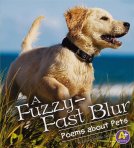
A Fuzzy-Fast Blur: Poems about Pets
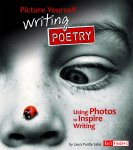
Picture Yourself Writing Poetry: Using Photos to Inspire Writing (See It, Write It)
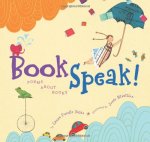
BookSpeak!: Poems About Books
Also by Violeta Dabija
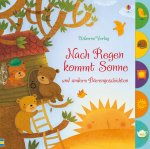
Nach Regen kommt Sonne und andere Bärengeschichten (After rain comes sun bears and other stories)
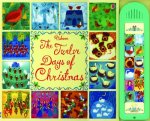
The Twelve Days of Christmas
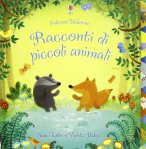
Racconti di piccoli animali. Racconti per la nanna (Stories of small animals. Stories for Bedtime)
.
.

Filed under: 5stars, Children's Books, Favorites, Library Donated Books, Picture Book Tagged: children's book reviews, forms of water, Laura Purdie Salas, Lerner Publishing Group, Millbrook Press, poetry, Violeta Dabija, water, water properties
Blog: Teaching Authors (Login to Add to MyJacketFlap)
JacketFlap tags: poetry forms, April Halprin Wayland, Adelaide Crapsey, Poetry, Poetry Friday, poem, Joyce Sidman, Laura Purdie Salas, Add a tag
I just read the beautiful book, Firefly July, full of super-short poems (I LOVE super-short poems) celebrating the seasons. Our own April Halprin Wayland is in there, and Joyce Sidman, and so many other fantastic poets.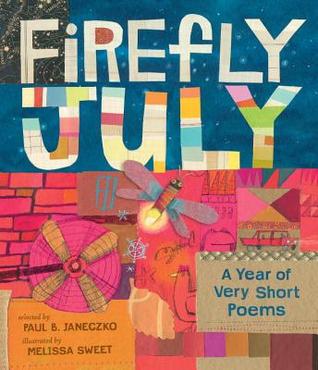
Here's one of my favorites. I adore both cinquains and fall, so this poem really hits me every time! This is by Adelaide Crapsey, who invented the cinquain form of 2-4-6-8-2 syllables.
November Night
Listen...
With faint dry sound,
Like steps of passing ghosts,
The leaves, frost-crisp'd, break from the trees
And fall.
--by Adelaide Crapsey, all rights reserved
It's Poetry Friday, and the very generous Jama Rattigan at Alphabet Soup has the Roundup today. Head on over and check out all the lovely poems!
We're talking about writing clippings here on Teaching Authors, so I will share a few of mine. I collect mostly two kinds of things: 1) bits of text from other books (usually fiction) that I think might make a cool jumping off point for my own poetry or picture books, and 2) articles I tear out of science magazines or bookmark that I think are good topics for assessment nonfiction or poetry passages.
Here are 3 random ones:
1) "serpentine spaghetti" - highlighted in a book I was reading on my Kindle. That has got to make it into a poem!
2) "We see their flights as perfect forward motion, but nothing could be further from the truth. In truth, every flap is followed by a tuck and a sweep, hasty and high stakes; hot on the heels of every flickering gain in altitude comes a small, heart-thudding drop." - a description of bird flight, also highlighted in a book on Kindle. I love this concept. No idea how I might use it in my writing, but I love it.
[I don't know what books the above came from. I just started saving highlighted quotes in a Word document a couple of months ago. I'm realizing that I need to also note what book they came from!]
3) http://discovermagazine.com/2012/oct/16-things-you-didnt-know-about-cars - Here's an article I read in Discover Magazine. Then I searched for it online and saved it as a bookmark, because my paper files are so overstuffed! I thought these nifty facts might spark a nonfiction passage for older readers.
Happy reading, writing, and clipping!
--Laura Purdie Salas
P.S. I'm in New Orleans for IRA and beignets! So I likely won't be able to respond to comments for about a week. But I'd love to hear from you:>)
P.S.S: From Carmela: If you haven't entered our current giveaway yet, don't forget to check out Jill Esbaum's post about her most recent publication, Angry Birds Playground: Rain Forest (National Geographic Books), and enter for a chance to win your own autographed copy.
Blog: Teaching Authors (Login to Add to MyJacketFlap)
JacketFlap tags: Blogiversary giveaway, favorite poem project, Poetry Friday, Rudyard Kipling, Blogiversary, Laura Purdie Salas, Add a tag
I hope you've been enjoying our sharing of some of our favorite poems. I've really loved hearing my fellow Teaching Authors read!
I could never choose one favorite poem, but this is definitely one I come back to again and again. It has several elements I adore: rhyme, nature, the ocean, gorgeous language, a melancholy but still comforting tone, and content that acknowledges the dangers in the world but promises safety anyway.
Seal Lullaby
Oh! Hush thee, my baby, the night is behind us,
And black are the waters that sparkled so green.
The moon, o’er the combers, looks downward to find us,
At rest in the hollows that rustle between.
Where billow meets billow, then soft be thy pillow,
Oh weary wee flipperling, curl at thy ease!
The storm shall not wake thee, nor shark overtake thee,
Asleep in the arms of the slow swinging seas.
—Rudyard Kipling
And here I am reading the poem:
I hope you're having a terrific National Poetry Month! There's so much amazing stuff being shared in our kidlitosphere--it's hard to keep up, isn't it? I do hope you'll take a couple of minutes to go to our Blogiversary Post and enter our giveaway. You could win one of five book bundles from one of the Teaching Authors:>)
Artist/writer/blogger/poet and all-around lovely person Robyn Hood Black has the Poetry Friday Roundup today at Life on the Deckle Edge. Have fun!
[posted by Laura Purdie Salas]
Blog: Teaching Authors (Login to Add to MyJacketFlap)
JacketFlap tags: Poetry Friday, Blogiversary, Laura Purdie Salas, similes, Poetry Month, metaphors, JoAnn Early Macken, April Halprin Wayland, Janet S.Wong, Sylvia Vardell, Blogiversary giveaway, favorite poem project, Add a tag
.
Howdy Campers ~ Happy Poetry Month! Happy Poetry Friday! And...
Happy 5th Blogiversary to us!
On April 22, 2009, powered by the dazzlingly bright solar power of Carmela Martino, we started this blog.
Five years--what a fabulous ride it's been!
Five candles. And when there are candles, someone makes a wish and blows them out. So you could say that this image represents the six active TeachingAuthors. (We're celebrating all TeachingAuthors who have been part of our blog biography.)
Campers, thank you from the bottom of our candles for reading, following, commenting and encouraging us. You're why we do this. You're why I'm terrified everytime a post is due. We want to add something meaningful and merry to the party! In celebration of You, this month's drawing is for one of FIVE "blogiversary book bundles." Each bundle is a set of five books hand-selected by a TeachingAuthor and contains at least one autographed TA book. Yay You! (Details below.)
LIBERTY
by Janet Wong from DECLARATION OF INTERDEPENDENCE – Poems for an Election Year
I pledge acceptance
of the views
so different,
that make us America
To listen, to look,
to think, and to learn
One people
sharing the earth
responsible
for liberty
and justice
for all.
Wow, right? So much substance packed into 12 lines.
- Laura is writing riddle-me haiku;
- I'm in love with metaphors, so I'm having a metaphoraffair this month;
- JoAnn will be posting poetry-themed Wednesday Writing Workouts here, while on her own blog she's adding more poetry writing tips and assorted poetry treats, including giveaways of Write a Poem Step by Step.
By now you're asking: "How can I enter to win a Book Bundle?
Our giveaway starts at midnight on Friday, 4/3 and ends at midnight of the day after our blogiversary, 4/23.
--You have a chance to win one of FIVE "blogiversary book bundles." Each bundle is a set of five books hand-selected by a TeachingAuthor and contains at least one autographed TA book.
--Books will be mailed directly to the winner, so winners must have a US mailing address.
--You have 3 entry options, and can enter via 1, 2, or all 3 options to increase their chances. (We DO verify that you've met all the criteria for each option. Incomplete entries will be disqualified.)
1) Tell us how you follow the blog (by "follow" we mean some sort of automated subscription service, such as via email, Facebook, Bloglovin', etc.) We have links in the sidebar to make it easy to start subscribing if you haven't already.
2) Leave a comment on THIS blog post. If you have difficulty commenting, you can submit comments via email to teachingauthors [at] gmail [dot] com. For this giveaway, you need to include in the comment either a) the title of a favorite poem OR b) the title of a favorite TeachingAuthor blog post.
Please be also sure to include your name in the comment so we can verify you've fulfilled this option. [Some folks don't comment with their real name and we have no way of knowing who they are!]
3) Help spread the word. Share a link back to this blog post from your own blog, or from Twitter, Pinterest, or any other way we can verify online. You must include the URL of the link in the space provided.
And good luck!
posted with love by April Halprin Wayland. Monkey's on vacation.
Blog: Teaching Authors (Login to Add to MyJacketFlap)
JacketFlap tags: picture books, Laura Purdie Salas, Jill Esbaum, writing poetry, writing classes Book Giveaway, Water Can Be..., Add a tag
First of all, I'd like to add my "WELCOME, Laura!" I’m so happy you’re here. Happy, too, about all the poetry you and April and JoAnn have been posting. That has me itching get back to writing more of my own (I was going to say you all were infectious, but that didn’t sound quite right).
Since we’re headed into conference season, I thought I'd post a relevant poem I wrote a few years back. Just before a fall conference, my SCBWI regional advisor called and asked if I’d get up on opening night and give sort of a “what not to do” talk regarding conference etiquette. (We’ve all heard horror stories of writers following visiting editors into bathrooms to talk about their manuscripts, right?) Then she added, “Make it funny. And how about writing it in rhyme?” Ack!
So, using a method very similar to Laura’s when she writes nonfiction poetry, I sat down and jotted a list of do’s and don’ts, then began tweaking and taking everything way over the top. Here’s the final product:
How to Impress an Editor
It’s my first time at a conference.
This? My brand new picture book.
Let me hold your glass of wine so you can take a better look.
See? It’s bound and fully laminated.
Here’s the copyright.
Just look at how the silver glitter sparkles in the light!
My nephew did the illustrations for me.
Aren’t they great?
I’m developing a series. This is number one. Of eight.
Yes, you are a little peaked.
Let’s go over there and sit.
What? You have to do the schmoozy thing and “work the room” a bit?
I’ll come with – and show you photos of Chief Kitchy-coo, my dog.
He’s the hero of my story (written all in dialogue).
See, he flies around Chicago with his mother, solving crimes.
It’s a shoe-in for that Printz Award.
And check this out … it rhymes.
There’s a song at the beginning.
There’s a moral at the end,
and a note reminding children that the story’s just pretend.
I’ve already got endorsements from the ASPCA,
and I’ve sent one to the Oprah show. I wonder … do they pay?
Oh, you have to hit the ladies’ room?
No problem. I’ll come, too.
While you’re taking care of business, I can read aloud to you.
Hon, is everything OK in there?
You need a helping hand?
What? You have a splitting headache?
Sure, of course I understand.
You can take my little story to your room and read it there.
No, it’s quite all right. Yes, I insist. I want you to, I swear.
Let me walk you to your suite.
Oh, it’s no trouble, none at all.
Well, for goodness sake, we lucked out. Look!
My room’s just down the hall!
Here’s an Advil for that headache.
Here’s my card. Know what? Take two.
Now, remind me of your name, hon, and … you edit books for who?
Take a hot bath.
Take it easy.
Don’t you let the bedbugs bite.
Ow, ow, ow! My foot was in there.
We’ll talk soon, then.
Nighty-night!
After I read the poem to the group, one editor took me aside and said that, sadly, the fictional writer of my poem wasn’t far off the mark. Yikes. Jane Yolen, who was one of our speakers, told me to send it to The Writer (which was still in business at the time). I did, and they published it in their April 2008 issue.
If you write rhyming picture books and haven’t yet signed up for Angie Karcher’s brand spankin’ new RhyPiBoMo, head on over and register: http://angiekarcher.wordpress.com
You can sign up until April 16th – and remember to enter the RhyPiBoMo Golden Quill Poetry Contest. Even if you don’t officially join in, you can follow along daily. Angie has lots of rhyming picture book authors lined up to post each day with tidbits of wisdom to help you improve your own rhyming picture books. See all the details on Angie’s site.
Jill Esbaum
P.S. If you haven’t yet entered for a chance to win Laura’s Water Can Be…, hurry! You only have a little more time!
Blog: Teaching Authors (Login to Add to MyJacketFlap)
JacketFlap tags: Poetry Friday, Book Giveaway, Laura Purdie Salas, Water Can Be..., Add a tag

I first read this poem just last month at Keri Recommends, and I love it! I've been immersed in writing educator materials and creating videos for Water Can Be... the past couple of months, and this celebration of what water does for our world completely enchants me. (The three stanzas I highlighted in blue are my very favorite--in case you don't have time for a longer poem today:>)
Winter Rain
Every dell and hollow:
Where the kind rain sinks and sinks,
Green of Spring will follow.
Yet a lapse of weeks
Buds will burst their edges,
Strip their wool-coats, glue-coats, streaks,
In the woods and hedges;
Weave a bower of love
For birds to meet each other,
Weave a canopy above
Nest and egg and mother.
But for fattening rain
We should have no flowers,
Never a bud or leaf again
But for soaking showers;
Never a mated bird
In the rocking tree-tops,
Never indeed a flock or herd
To graze upon the lea-crops.
Lambs so woolly white,
Sheep the sun-bright leas on,
They could have no grass to bite
But for rain in season.
We should find no moss
In the shadiest places,
Find no waving meadow grass
Pied with broad-eyed daisies:
But miles of barren sand,
With never a son or daughter,
Not a lily on the land,
Or lily on the water.
--by Christina Rossetti
Isn't that amazing? And here I am reading this poem aloud:
And this is the final day of our weeklong celebration of Water Can Be... here on Teaching Authors. Thanks for letting me share so much! If you're interested in book trailers, the teaching guide, reviews (it got starred reviews from Kirkus and Publishers Weekly--my first stars ever!), etc., just check out the Water Can Be... page on my website. And don't forget to return to Monday's post to enter our giveaway for a personalized copy of my book. Just click on the Rafflecopter widget at the bottom of that post. Good luck!
Teacher and poet Mary Lee Hahn at A Year of Reading has today's Poetry Friday Roundup--enjoy!
--Laura Purdie Salas
Blog: Teaching Authors (Login to Add to MyJacketFlap)
JacketFlap tags: Nonfiction, rhyme, Laura Purdie Salas, Wednesday Writing Workout, Water Can Be..., Add a tag

Kids (and grown-ups) love to write in rhyme, but it’s a lot harder than it looks. And it gets even tougher if you’re trying to write nonfiction in rhyme! So, here's an exercise for those interested in writing rhyming picture books. This could also be a fun classroom activity where you ask students to synthesize information learned in a particular math or science or history unit. (I wouldn’t even attempt something like this with students younger than 5th grade, though, and even then, working as a group will be a lot more successful.)
1. Pick a topic you want to write a short poem about. I think I’ll do, um, fences. Yup, fences. Pick something you’ve never written about and don’t actually want to write a whole poem or picture book about. That will make this less stressful!
2. Define your topic in a first line. That’s a place to start. m-w.com tells me a fence is “a structure like a wall built outdoors usually of wood or metal that separates two areas or prevents people or animals from entering or leaving.” OK, I’m going to start with:
A fence is like an outside wall
Because it ends in wall (and, yes, I purposely picked a simplish word that I know will have rhyming possibilities to end the line with), I’m going to brainstorm and/or look up on rhymezone.com words that rhyme with wall that might in some way work into this poem: all, ball, crawl, fall, tall,
3. Add detail in rhyming line.
A fence is like an outside wall:
Wood or metal, short or tall.
4. Decide what else you want to tell about your topic. I like the idea that fences sometimes keep people or things or animals IN, and sometimes keep people or things or animals OUT. So that’s what I want my second half of this poem to convey. In and out are the main elements of that concept, so I’ll check out some rhyme possibilities and see where that leads me:
in – bin, grin, skin, twin, win
out – about, doubt, shout, trout
Well, those lead me pretty much nowhere, at least at first glance. Maybe I’ll try inside and outside, instead:
cried, died, tried, wide
Again, a big, fat nothing.
So, I switch gears. WHAT does it keep inside? Kids and dogs is what I’m mainly thinking of. And what does it keep outside? Strangers, people that might get hurt on whatever’s inside the fence...
While, I was thinking about that, the word divide popped into my head, which would rhyme with inside or outside. So I’m going to play with that.
5. Now try another couplet to show your concept.
A fence’s job is to divide.
A fence keeps beagles safe inside.
I don’t like that because it’s not clear. And the two lines don’t really connect. No cause or effect. Each line is true, but there’s no relationship between them. I’ll try again.
I think that second concept is too big for two short lines. I’m going to simplify to the concept that a fence keeps animals safe.
A fenced-in pasture, green and wide,
keeps grazing cattle safe inside.
6. Read over the four lines you wrote. Congratulations!
A fence is like an outside wall:
Wood or metal, short or tall.
A fenced-in pasture, green and wide,
keeps grazing cattle safe inside.
OK, mine is not going to win any prizes, but it’s a start! I have a basic definition, a bit of detail, and then a single example of one kind of fence and its job. In reading it, I see some possibilities for re-ordering and revising lines. So my second draft is:
Wood or metal, short or tall,
a fence becomes an outside wall.
Rolling meadow, green and wide,
cattle safely fenced inside.
Again, this is just very basic. But doing this exercise can help you build some rhyming/meaning muscles, so it's a great practice activity for any would-be rhymers!
Here are a couple of bits from my first draft of A River Can Be…, which eventually turned into Water Can Be…. You can see this process at work here. It’s just a combination of picking a word I KNOW works for the topic, brainstorming rhymes, and then trying out lines with those other rhymes to see which ones work both for rhyme AND for topic.
And when a word didn’t have enough rhymes to play with (like haven), I tried a synonym that was more rhyme-friendly. I hope you have fun trying your hand at a little bit of rhyme today!
I'd love to see what you come up with! Feel free to share your four lines in the Comments!
Oh! And don't forget to enter our book giveaway of Water Can Be...! by clicking on the Rafflecopter widget in last Monday's post.
--Laura Purdie Salas
Blog: Teaching Authors (Login to Add to MyJacketFlap)
JacketFlap tags: Book Giveaway, Laura Purdie Salas, How I Became a Teaching Author, Water Can Be..., Add a tag
When I was a kid, I had no thought of being an author OR a teacher! As the youngest of four girls, I was always one of the students when we played school. As I think of my sisters, Miss Trunchbull comes to mind—ha! I never ever got to be the teacher! (On the plus side, this helped me become an early and voracious reader). And while I loved to read, it never occurred to me that real people wrote all those books I devoured.
| With my big sisters, Janet (left), Gail (center), and Patty (right). I'm the peanut in front. |
When I started college, I planned to be a veterinarian. My first creative writing class killed that plan, and I knew I would do something with books, reading, and writing. That something turned out to be LOTS of things.
First, I became a magazine editor. When the publication was sold, I decided to try teaching (I was certified for Secondary English). I taught 8th-grade English for two years, and it was exhilarating, exhausting, and life-changing. I knew I did not have the stamina to stay in it for the long haul and try to be an amazing teacher while dealing with administration, assessment (even back then!), politics, and parents. But I loved my 8th graders and their wild creativity—and the books we were constantly reading.
| Our two daughters, ca. 1998 |
Then my husband and I moved to Minnesota. While doing freelance writing for grown-ups, I held part-time jobs over the years as a copyeditor, a personal care assistant for young adults with disabilities, a teacher in our school-age latchkey program, etc. When we had kids, the thousands of books we read with them nourished that seed and helped it grow: I want to write books for kids.
So, of course, I joined SCBWI and set to work learning how to do that. In October of 1999, I went to a local SCBWI conference, where two editors from educational publishers spoke. Because I was conference volunteer, I got to be one editor’s helper and I got a manuscript critique with the other. I ended up writing books for both companies.
 |
| BookSpeak! Poems About Books (Clarion, 2011) |
Even though that was by far NOT my first choice.
And thus began my history of writing children’s books. To date, I have written about 110 nonfiction books for the educational market, 12 poetry collections, and two rhyming nonfiction books. In fact, my newest book, Water Can Be..., comes out on April Fool's Day, and we're doing a giveaway of it here on TeachingAuthors.com! You can enter using the Rafflecopter widget at the end of the post. Enter through April 1, 2014, the pub date of Water Can Be...!
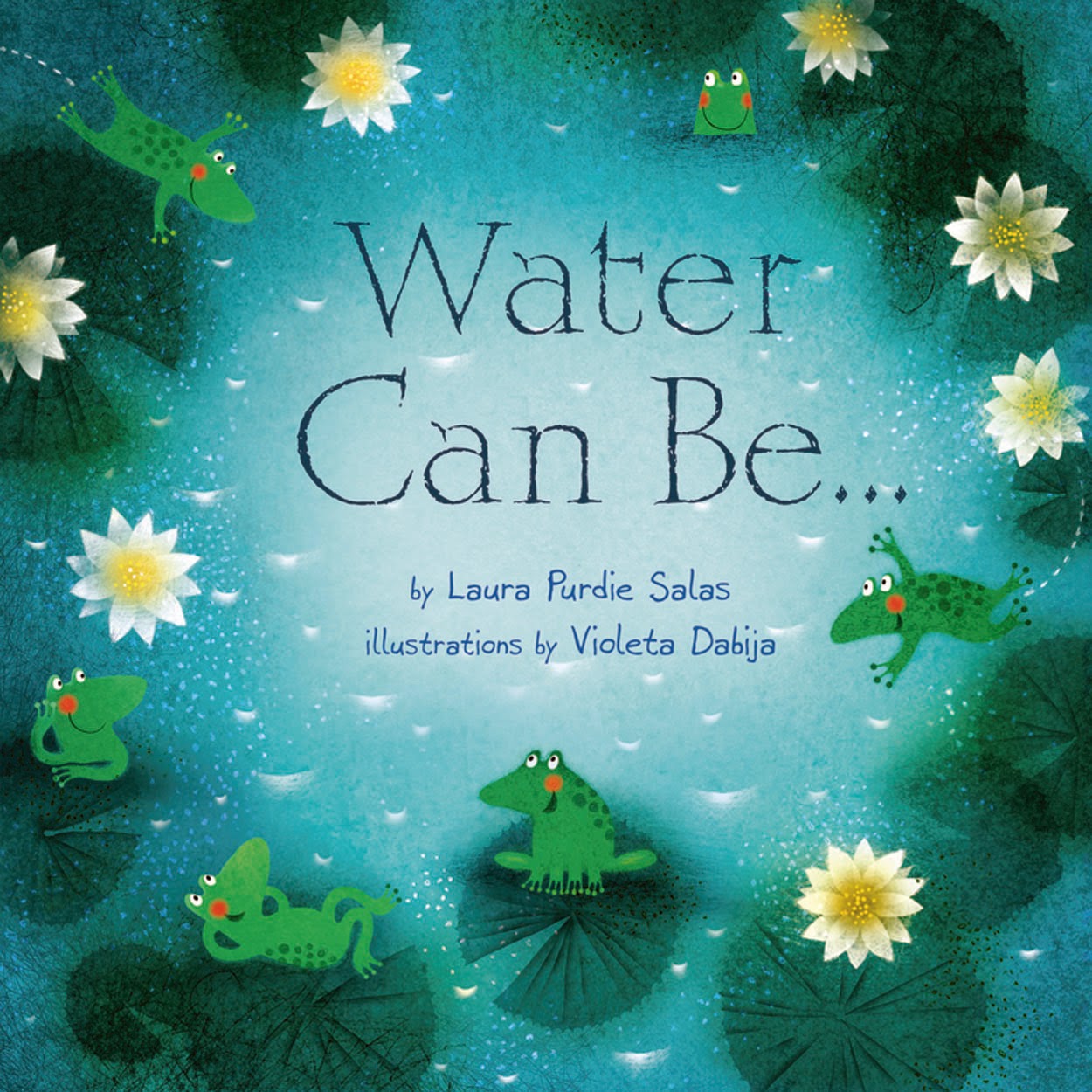 |
| Water Can Be... comes out on April 1! |
| At a school visit in 2013 |
I also get to present to educators and librarians, which I love! I’m usually spreading poetry joy—in fact, in a couple of weeks, I’m going to present at the UNLV conference. I can’t wait. Presenting through IRA, ALA, and NCTE have been highlights for me.
And I get to connect to kids, too, through elementary author visits and young authors conferences. I have a blast getting kids excited about reading, writing, and poetry. And I don’t have to assess them or do any of the other ongoing tasks teachers have to keep up with.
 |
| A Leaf Can Be... (Millbrook, 2012) |
My work as a teacher and an author are entwined in my mind. I can’t imagine one part of my career without the other. If I weren’t a writer, I obviously wouldn’t be invited to speak to teachers and writers and students. But if I didn’t do the teaching, I do think my writing would suffer. Getting out there and being in schools, with kids, helps me stay in touch with kids’ real lives today, especially now that my own two are officially adults—gulp.
And…that’s probably more than you ever wanted to know about my writing journey!
--Laura Purdie Salas
a Rafflecopter giveaway
Blog: Teaching Authors (Login to Add to MyJacketFlap)
JacketFlap tags: writing life, writing time, Laura Purdie Salas, writing rituals, Add a tag
Hi! I’ll introduce myself more in a future post, but I’m Laura Purdie Salas, a temporary Teaching Author. I’m so happy to be here!
Rituals. Hmmm…I was treadmilling the other night, listening to a lovely episode of NPR’s Backseat Book Club featuring Lucy Dahl, Roald’s daughter. Start at 3:40 for a fascinating glimpse into Roald’s writing setting and rituals. I wish I had such definite, comforting rituals. But I don’t.
I do have a few elements I return to, though: light, movement, and time.
 |
| Photo: Ikea |
1) Light – Sometimes I light a little candle before writing. A flickering light sets my mind at rest, somehow. I have a lantern given to me by a dear writer friend that I love to write by.
When I’m lazy but still want that flicker, I light my little febreze fake candle:>) Excuse me: Febreze Flameless Luminary.
And when I’m super-busy, I just write by a window, with the blinds slatted upward so I get glimpses of trees and sky, but not distracting cute bunnies in the yard.
2) Movement: When I’m frustrated with my writing, I move. Can’t think of the right word? I’ll pace around the kitchen/dining room circle, or go walk Capt. Jack (when it’s not 20 below zero), or even just stand up and do 30 squats.
| Photo: DuBoix, courtesy of Morguefile |
3) Time: Deadline-setting is really my only consistent ritual. I learned to be a writer in tiny bursts while blocking out life stresses. I still write best in small, intense chunks. No matter what kind of project I'm working on, I start the same way. I look at the clock. I look at the project. Panic shoots through me at my day's to-do list. Then I breathe and set a timer. “Rough draft of this poem. 20 minutes. Go.” Even if I have 3 straight hours of writing time, I probably work on 3-5 different projects during that time, each with its own deadline.
So, there you have it. Three sort-of routines. It would probably be simpler if I just started with a mug of cinnamon tea every day or something:>)
--Laura Purdie Salas
Blog: Teaching Authors (Login to Add to MyJacketFlap)
JacketFlap tags: Laura Purdie Salas, Carmela Martino, Teaching Authors, Add a tag
I mentioned a few weeks ago that a new TeachingAuthor will be filling in for Mary Ann while she's gone. Today, I'm happy to welcome our newest TA (drumroll please!):
Although I've only met Laura virtually, through reading her blog posts, and via email and telephone, I can already tell she'll be a wonderful addition to our team. In case you don't know Laura or her work, here's a brief bio:
Laura Purdie Salas is the author of more than 120 books for kids and teens, including two recent books from Millbrook Press: Water Can Be ... and A Leaf Can Be ... (Bank Street Best Books, IRA Teachers' Choice, Minnesota Book Award Finalist, Riverby Award for Nature Books for Young Readers, and more), and Bookspeak! Poems About Books, published by Clarion (Minnesota Book Award, NCTE Notable, Bank Street Best Book, Eureka! Gold Medal, and more). She loves to introduce kids to poetry and help them find poems they can relate to, no matter what their age, mood, and personality, and she loves to get teachers excited about sharing poetry in their classrooms. She has also written numerous nonfiction books.That's right, she's written over 120 books! Pretty amazing.
You can read more about Laura and her work at her website. You can also Like her on Facebook and/or Follow her on Twitter @LauraPSalas or check out her writing coaching and critiquing services through Mentors for Rent.
 I hope you'll give Laura a hearty welcome when she posts here for the first time on Friday.
I hope you'll give Laura a hearty welcome when she posts here for the first time on Friday.Also, be sure to join us again later this month when we celebrate the official release of her beautiful new book, Water Can Be ... .
Happy Writing!
Carmela
Blog: TWO WRITING TEACHERS (Login to Add to MyJacketFlap)
JacketFlap tags: poetry, giveaway, Laura Purdie Salas, J. Patrick Lewis, georgia heard, Add a tag
Have you ever found a poem? I’m not talking about something with stanzas, line breaks, and the other traditional things that typically make a poem a poem. I’m talking about finding something poetic in ordinary prose, on a street sign, in an advertisement, or even inside of a fortune cookie. The Arrow Finds Its Mark: [...]![]()
Blog: Tara Lazar (Login to Add to MyJacketFlap)
JacketFlap tags: Picture Books, Laura Purdie Salas, BOOKSPEAK, STAMPEDE, PiBoIdMo 2011, Add a tag
Congratulations on completing PiBoIdMo!
This activity generates such a feeling of abundance. Ideas everywhere! Some of these ideas have great promise, and some of them…don’t.

Photo: Daniel Plazanet (Daplaza)
I characterize ideas as pebbles or seeds. Pebbles are hard and immutable. They might be shiny, or pretty, or just dusty. But whatever they are, they’re rocks. They aren’t going to grow into something different.

Photo: Mrmariokartguy
But seeds…oh, seeds! Some look like pebbles. They seem hard and small and nondescript at first. But if you nurture them with questions, and time, and creativity, the seed ideas can grow into more—like a picture book.
So, how do I sort them out? I ask questions. I play around with answers. I try to be honest, even when I don’t want to. Here are some of the things I ask:
One premise from my PiBoIdMo list this year is: “I Won’t Come Down: Rhyming pb from pov of a kitten stuck in a tree. With a refrain? Who tries to get me down? Kid climbs up, but I climb higher. Fire truck? Where’s the fire? Need a personality for the kitten. Is she witty and clever? Scared to death? Sassy?”
1) Who is my main character?
Does my idea or premise suggest a particular character? Does she fit the situation perfectly? Or totally clash with it? In this case, as I re-read the idea, I know my main character kitten HAS to be a witty, clever girl. She appears to be stuck in the tree, but she’s really perfectly happy up there.
2) What is the conflict?
Easy-peasy. Everybody assumes she wants to get down, but she doesn’t. Sometimes the conflict isn’t obvious. Another of my ideas is about a pet cloud. Just an idea—but I don’t have a clue what the conflict would be (yet).
3) Does it make me ask more questions?
A good idea expands. It makes me want to explore possibilities. My treed kitten does that for me.
4) Has it been done a million times?
Uniqueness is key in publishing picture books. I’ve had manuscripts turned down recently that editors said they loved but that were “too similar” to books already published—even though the similarity is broad at most. In this tight market, publishers don’t want two “pet books” or whatever. I start on Amazon. I find 27 picture books including the words “kitten” and “tree” published over the past 25 years. Dang. That doesn’t mean any of them have the same premise, but I’ll need to do further research.
5) Can I see the book in my mind?
Picture books, of course, need pictures. Does my idea make me immediately visualize tons of images?
6) Is it a seed that will grow a short story instead of a picture book?
It can take years of reading to absorb the intrinsic difference between the two forms. Illo potential is part of it, but there’s more. If your idea depends on a twist/joke ending, it’s likely to be a short story. (The ending of a picture book should be surprising and satisfying, but not a joke/punchline.) If you can picture one great illo for it, but not 14, it’s a short story. If it involves complex plot points and many details, it’s a short story.
7) Does it stand up to repeti
Blog: my juicy little universe (Login to Add to MyJacketFlap)
JacketFlap tags: seasons, son, Joyce Sidman, Laura Purdie Salas, punctuation, William Carlos Williams, Frank O'Hara, Add a tag
 My son is 8 and although he knows a lot about the world, I'm sometimes surprised at what I assume he knows and doesn't. We had another 2" of snow overnight on Tuesday and therefore (somewhat absurdly) a 2-hour delay on Wednesday, so we had time to gear up and head out to the bus stop half-an-hour early. It wasn't great snowball snow--fine and flaky and extra-sparkly in the sun--so we found other ways to amuse ourselves, like shaking snow off branches (and is there anything more beautiful than dark branches frosted in sparkling snow against a blue, blue sky?) .
My son is 8 and although he knows a lot about the world, I'm sometimes surprised at what I assume he knows and doesn't. We had another 2" of snow overnight on Tuesday and therefore (somewhat absurdly) a 2-hour delay on Wednesday, so we had time to gear up and head out to the bus stop half-an-hour early. It wasn't great snowball snow--fine and flaky and extra-sparkly in the sun--so we found other ways to amuse ourselves, like shaking snow off branches (and is there anything more beautiful than dark branches frosted in sparkling snow against a blue, blue sky?) .
"Look at all the buds," I said. "They know spring will come again even though it doesn't feel like it now." I bothered to say it out loud because this knowledge added to my hopeful, sunny, fresh-air feeling. Duncan looked up and said, "What buds?" You know, like he'd never heard of buds. I pointed out the little textured teardrops at the end of each twig on the--actually I don't even know what kind of tree we were standing under. "Each of those is a tiny beginning of a leaf, just waiting for the weather to warm up." "Really? Cool," he replied, and went to jump daringly into the snow from a wall which is rumored to contain a snakehole.
There was time when I eschewed exclamation marks as a sign of weak writing in need of bolstering by flashy punctuation. Frank O'Hara changed my mind about that (and has inspired many others), and see how WCW uses one surprisingly! in this otherwise softspoken poem. I think it renders perfectly the feeling we have when we can cross something big off our to-do list, relax and store up wisdom. Hm. I miss that feeling...
Winter Trees
by William Carlos Williams
All the complicated details
of the attiring and
the disattiring are completed!
A liquid moon
moves gently among
the long branches.
Thus having prepared their buds
against a sure winter
the wise trees
stand sleeping in the cold.
Enjoy Poetry Friday today with Laura Purdie Salas at Writing the World for Kids--and congratulations indeed to Joyce Sidman for her Newbery Honor medal--it'll look great on the cover of Dark Emperor. Go Poetry!
Blog: Where The Best Books Are! (Login to Add to MyJacketFlap)
JacketFlap tags: Laura Purdie Salas, Steven Salerno, 2009, Stampede Poems to Celebrate the Wild Side of School, poems about school, Add a tag
View Next 3 Posts








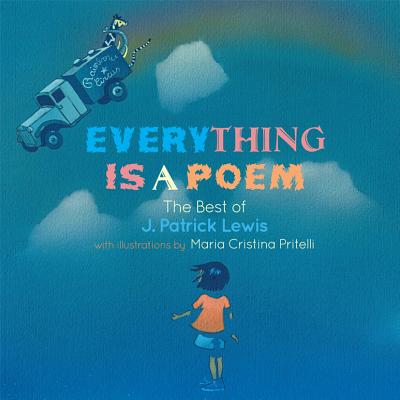















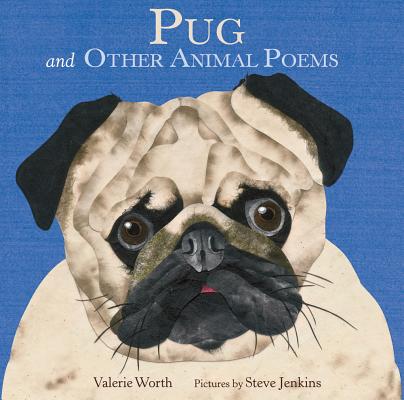




 by
by 
Thanks for some thoughtful ideas about getting our little idea seeds to germinate. Love the idea of even putting the rocks to work!
Wonderful advice on how to grow my ideas into picture books. Thanks, Laura! And congrats on your new book!
Love the pebbles border. *smiling* Great questions and super analogy with the pebbles and the seeds. I have a picture book about a cat stuck in our tree. It is a true story. Not rhyming though. Now for the fun part. Actually writing these stories.
Great information, I am printing this off as a reminder when I am going back through my ideas.Pebble or Seed, that is the question?
Ah, but pebbles…. you crack them open and maybe there’s a glint of pyrite or a brachiopod or …..
Being a gardener, however, I tend to think in terms of germinating ideas and nurturing stories. Thanks for the images.
Wonderful post, Laura!
Most of my ideas are pebbles. But one of them turned out to be a real deal seed.
Helpful, thank you.
I am going to print this post and keep it on my desk as I go through my ideas. Very helpful!
You have to find a lot of pebbles before you find a seed –
Thank you for the practical advice on how to tell if your idea will take root, Laura–I especially liked your short-story-or-picture-book test: most helpful!
Thank you Laura this is great advice. I’m sure out of a month’s worth of ideas there has to be some seeds mixed in with some pebbles.
Thanks for all the thoughts about how to work with our ideas. Hoping for some seeds!
Love the post. This is a bit scary, for me, but I like writing pet books and I had a kitten stuck in a tree on my idea list. Now what? If I do it now I will feel like I stole an idea.
Has this ever happened to anyone else, and if so, what did you do?
Thanks, Laura. I’ll use these ideas to test my seeds. It’s great to have this continued encouragement after birthing PB ideas for a month! I’m looking forward to reading your new book.